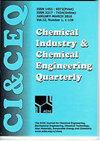Bed expansion in turbulent bed contactor: Experiments and prediction
IF 0.8
4区 工程技术
Q4 CHEMISTRY, APPLIED
Chemical Industry & Chemical Engineering Quarterly
Pub Date : 2023-01-01
DOI:10.2298/ciceq230304010b
引用次数: 0
Abstract
In this work, the hydrodynamics of the turbulent bed contractor (TBC) have been studied in terms of bed expansion (Hd/Hst) using a particular approach for the prediction of this important property for the design of such equipment. The study is based on 1604 sets of experimental data of the bed expansion, obtained by varying the operating variables (gas velocity, liquid spray, packing characteristics, static bed height and free opening of the supporting grid. The prediction of the bed expansion necessitates the estimation of gas and liquid holdups. To achieve this, we employed a variety of correlations derived from existing literature, comprising six equations for gas holdup and twenty equations for liquid holdup estimation. Out of a total of 120 cases, bed expansion was estimated, and the accuracy of the model was evaluated by calculating the mean absolute error in percentage (MAPE), root mean square error (RMSE), correlation coefficient (?XY), and explained variance (VECV). This study enabled the identification of suitable correlations for gas and liquid holdups, leading to predictions with acceptable errors. Furthermore, statistical analysis was employed in a subsequent phase of the study to determine the most appropriate correlations for predicting bed expansion among those proposed by various authors.紊流床接触器的床膨胀:实验与预测
在这项工作中,紊流床承包者(TBC)的流体力学已经在床膨胀(Hd/Hst)方面进行了研究,使用了一种特殊的方法来预测这种设备设计的重要性质。该研究基于1604组床层膨胀实验数据,通过改变操作变量(气速、液体喷雾、填料特性、静态床层高度和支撑网格的自由开度)获得。床层膨胀的预测需要估算气液含率。为了实现这一点,我们采用了来自现有文献的各种相关性,包括6个气体含率方程和20个液体含率估计方程。在总共120例病例中,估计床位扩张,并通过计算平均绝对误差百分比(MAPE)、均方根误差(RMSE)、相关系数(?XY)和解释方差(VECV)来评估模型的准确性。这项研究能够确定气液含率的适当相关性,从而得出可接受误差的预测。此外,在研究的后续阶段,采用统计分析来确定各种作者提出的预测床层膨胀的最合适相关性。
本文章由计算机程序翻译,如有差异,请以英文原文为准。
求助全文
约1分钟内获得全文
求助全文
来源期刊

Chemical Industry & Chemical Engineering Quarterly
CHEMISTRY, APPLIED-ENGINEERING, CHEMICAL
CiteScore
2.10
自引率
0.00%
发文量
24
审稿时长
3.3 months
期刊介绍:
The Journal invites contributions to the following two main areas:
• Applied Chemistry dealing with the application of basic chemical sciences to industry
• Chemical Engineering dealing with the chemical and biochemical conversion of raw materials into different products as well as the design and operation of plants and equipment.
The Journal welcomes contributions focused on:
Chemical and Biochemical Engineering [...]
Process Systems Engineering[...]
Environmental Chemical and Process Engineering[...]
Materials Synthesis and Processing[...]
Food and Bioproducts Processing[...]
Process Technology[...]
 求助内容:
求助内容: 应助结果提醒方式:
应助结果提醒方式:


